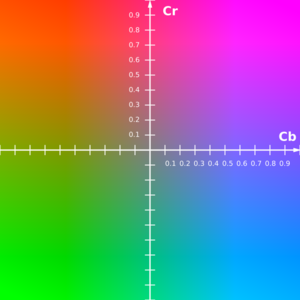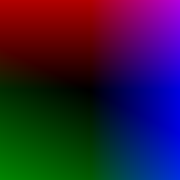YCbCr color model

The YCbCr color model was developed for digital television in accordance with the PAL standard, but is also used today for digital NTSC television. It is also used in the CCIR-601 standard for digital image and video recording, JPEG images, MPEG videos and thus also for DVDs , video CDs and most other digital video formats .
The YCbCr model divides the color information into the basic brightness Y and the two color components Cb ( Blue-Yellow Chrominance ) and Cr ( Red-Green Chrominance ). With Y, the brightness axis from the CIE standard valence system is used. It corresponds to the light sensitivity of the eye, which is greatest in the green spectral range ( V-lambda curve ). Chrominance or short Chroma means variegation in general and color in terms of brightness-color models.

General
Color models that do not specify a color location by three basic colors like the RGB color space , but by brightness and color , are called brightness-color models . The coordinates are, for example, the basic brightness (from black to gray to white), the hue with the largest proportion and the saturation of the color (from "bright" to pale).
Like the YUV color model for analog color television, in which the basic brightness corresponds to the pure black and white image, the YCbCr model is a pure brightness-color model. If you compare the two separations in the image example in YUV and YCbCr, it becomes apparent that the brightness channel shows a completely achromatic grayscale image and that only the chrominance axes U and V in the color table intersect other color tones than Cb and Cr, as the respective color table above shows. Cb is therefore a measure of the deviation in color from gray towards blue / yellow, Cr is the corresponding measure towards red / turquoise.
Note that a color model is not yet a color space , because it does not yet specify which colors are meant by “red”, “green” and “blue”. A reference to absolute color values is also required for a color space . In addition, both color models differ from the similarly structured CIELAB color space in that brightness, chrominances and color tones are not perceptually equally spaced.
Analogy to the sense of sight
The different perception of Y compared to the Cb and Cr channels corresponds to the development of the color and brightness distribution in nature. Much information is stored in the brightness, the color hardly varies.
In the course of evolution , the human sense of sight has adapted to this. The eye can recognize small differences in brightness better than small differences in color tone, and these in turn can better recognize small differences in color saturation. A text written gray on black is easy to read, but written blue on red with the same basic brightness is very difficult to read.
As in every brightness-chromaticity system based on human visual perception , colors in the YCbCr color space are also mutually exclusive. This means that a blue can never have yellowish nuances (and vice versa) and a red can never have green or turquoise nuances (and vice versa). This structure corresponds to the processing of color information in the eye and brain ( Hering's counter-color theory ).
Color subsampling
The analogy to the human sense of sight is used for a major advantage of YCbCr: color subsampling ( chroma subsampling ). The sampling rate and thus the amount of data of the chrominance channels Cb and Cr are reduced compared to the sampling rate of the luminance channel Y without any noticeable reduction in quality. So you can z. As with the JPEG - compression save 50% of the amount of data.
Conversion between RGB and YCbCr
Before the conversion, the values for RGB must be normalized with a gamma correction to the interval [0; 1]. The color triple formed is usually referred to as R'G'B ' to distinguish it in the literature . The YCbCr values are digitized to a specific resolution and, if necessary, provided with an offset to avoid negative values. So before the YCbCr data can be determined, the so-called YPbPr values are calculated from the R'G'B'-color data . These values of YPbPr are fixed to the value range [0; 1] for Y and [−0.5; +0.5] are limited for the two color components PbPr and are not subject to any limitation in terms of resolution, they are analog signals. With a certain resolution, for example 8 bits per value with a value range of {0, 1, ..., 255}, the values Y′CbCr are formed from the Y′PbPr values, each in the value range of {0, 1, ..., 255}. However, with Y′CbCr a mapping to 10 bits with a value range of {0, 1,…, 1023} can also be made. This resolution is used because of the higher color dynamics in the studio. The gamma correction of R′G′B ′ only affects the brightness signal Y ′. The spelling should therefore correctly be Y′CbCr instead of YCbCr.
The following equations show the general calculation of the Y′PbPr value triples without first referring to a specific standard:
The constants Kr and Kb that occur are defined in ITU-R BT 601 (formerly CCIR 601 ) for television in the standard definition SDTV .
They are therefore dependent on this standard and are set with Kb = 0.114 and Kr = 0.299. The choice of these coefficients is determined from the display properties of the cathode ray tube . The following formulas result as ITU-RB.601-compliant conversion for Y'PbPr values.
These values are digitized with a desired resolution and provided with an offset and converted to YCbCr values. The offset is necessary to keep reserved values such as 0 and 255 free for special control tasks (synchronization) in the case of digital video data. The values in the "Reserve above" or "Reserve below" area are reserved for overdriving the video signals and should not be used.
The following overview shows the digitization for an 8-bit dynamic. The lower reserve is {1, 2, ..., 15}, the upper one of {236, 237, ..., 254}, the synchronization values {0, 255}. Y ′ is in the range of values {16, 17, ..., 235} and Cb and Cr in {16, 17, ..., 240}:
If the R'G'B'-data is already available digitally as R ' d G' d B ' d in the value range {0, 1, ..., 255}, the conversion for 8-bit dynamics is carried out using the following formulas:
The small deviations of the coefficients in the matrix result from the factor 256/255. As mentioned above, this form of conversion is primarily used for the digital representation of analog PAL - in NTSC color television signals in standard definition of SDTV .
With the HDTV standard ITU-R BT.709, different constants are used for Kb, Kr, which leads to different transformation values. The following applies: Kb = 0.0722 and Kr = 0.2126 according to the display options of LCD and plasma screens. The matrices must then be calculated accordingly.
There are a large number of other standards for YCbCr color conversion. The SMPTE 240M standard defines these constants as Kb = 0.087 and Kr = 0.212. The YCC color model from Kodak is optimized for photo paper.
The YCbCr transformation in JPEG and MPEG also uses this color model. Since JPEG does not have to map any synchronization values in the image data stream, the full range of 8 bits can be used for the values of YCbCr, i.e. {Y ′, Cb ′, Cr ′} and also R, G and B are in the value range {0, 1 ,…, 255} possible.
- CbCr surfaces with different Y values
literature
- Charles Poynton: Digital Video and HDTV Algorithms and Interfaces . Morgan Kaufmann Publishers, San Francisco 2003. ISBN 1-55860-792-7
Web links
- Difference between the different sampling rates at YCbCr
- YCbCr data formats
- [1] in English by Gary Sullivan and Stephen Estrop







